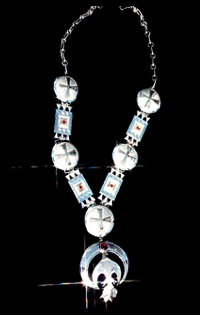
Through gifting and the exchange of new materials, wealth was created on both sides. Interestingly enough, both sides met as equals whereby both parties exchanged valuable knowledge.
Much of the early trade silver was exchanged with the indigenous tribes of the northeast region of North America and eventually with the tribes in the mid-continent. Worth noting is the fact that— as art would have it— art inspired the indigenous population to make their own silver creations and adapt the metal into their culture.
As European and American traders made their way west in the 1700 and 1800's they also brought new items and tools to the Lakota Nation such as metal knives, guns, needles, scissors, cooking utensils, axes, files and many other utilitarian items. Although somewhat isolated from the initial trading in the 1600's, the Lakota attained various trade silver items through inter-tribal trade events. Some Lakota then incorporated silver items as elements of personal adornment. This is evidenced in the portraits painted by several ethnographers.
There were other various historical events that eventually brought silver and various ferrous and non-ferrous metals to the Northern Plains. Decisions within the administrative history of the United States forced marched and displaced Eastern and South Eastern tribes of the United States in the mid 1800's to the "Indian Territories" in the present state of Oklahoma. Among these federally displaced tribes were the Northern Plains Cheyenne and Arapahoe. To this day, the Cheyenne and Arapahoe Nations remain geographically split.
This United States Federal Government imposed movement and eventual settlement of displaced nations, caused and made way for the influence and amalgamation of cultural expressions in metal and silver from the southeastern and southwestern tribes in Oklahoma to eventually reach up into the northern Plains. Blended with additional influences of the Spanish and Southwest Indian silverwork, the Indian territories produced classic innovations that today are very much collectible.
These expressions of silver adornment in Northern Plains Indian culture is well documented in the ledger drawings produced in the later 1860's and 1870's by the Cheyenne and Lakota historians. These ledger drawings profiled and indicated the use of silver as personal adornment for individuals and horses. Such items of adornment were arm bands, wrist cuffs, hair plates, earrings, cross and chest pectorals and horse bridles. Interesting enough, the Plains Indians were by now producing their own metal and silver adornment.
By the 1880's, photographs taken showed the sophistication and innovative designs of Plains Indian silver adornment. These adornment items and designs adhered to a natural symmetry in shape and employed rudimentary tools to scribe, engrave and stamp designs on the surface of silver. Many of the designs and motifs were personal and definitely within the expressions of the Plains Indian culture.
By the early 1900's and into the mid-century mark, the Native American Church and Peyote Religion within the Indian Territories of Oklahoma influenced and produced phenomenal expressions of Indian spirituality with and on an alloyed metal. German Silver (which is made up of 60% copper, 20% zinc and 20% nickel and was invented in the 1820's), was used in jewelry items traded by Europeans and Americans to the Indian nations. Along with the spread of the Native American Church / Peyote Religion, the expressions in metal continue as an inspirational example of the attributes of Plains Indian culture to adapt new materials and "Indianize" these new materials to the benefit and proliferation of the culture.
The history herein described is synoptic and very much generalized. However, this information will hopefully provide a basis for understanding some of the influencing historical events, as well as the attribute of native cultures to adapt to new materials in order to provide a future for generations yet to come.